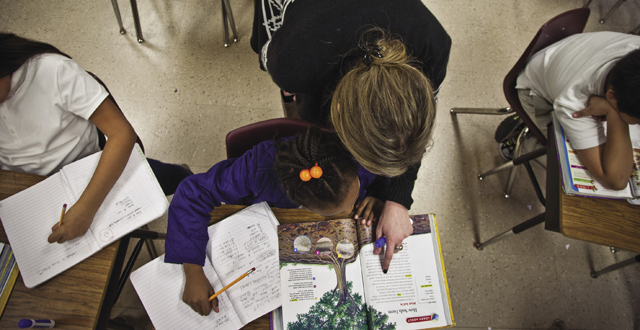When it comes to education, Preston Hollow is full of choices. Pretty soon, public school might actually become a stronger contender on that list.
Dallas ISD approved the International Baccalaureate program for Preston Hollow Elementary, Franklin Middle School and Hillcrest High School.
The IB curriculum focuses on trans-disciplinary, cross-cultural education aimed at developing better critical-thinking skills and helping students, essentially, “learn how to learn.”
The program has successfully been implemented at Woodrow Wilson High School and at its feeder school J.L. Long Middle School. As the IB coordinator there puts it, “We’re teaching to think versus just filling students up with rogue knowledge.”
IB is designed to help prepare students not just for college but also for the world.
“Our whole educational process is looking toward a global perspective,” says Nora Berry, executive director of the Hillcrest feeder pattern.
The program would replace the current curriculum at the elementary and middle school level. At the high school level, students can opt in, and that’s where it takes some serious commitment.
“I call it Advanced Placement on steroids,” says Preston Hollow’s DISD trustee, Mike Morath, who graduated with an IB diploma from Garland High School, having accumulated 36 hours of college credit. “It’s a way to inject rigor into a campus.”
The process begins with Preston Hollow Elementary, where administrators will submit the application for the Primary Years program in April. Upon acceptance, there’s a three-year implementation period. The process starts over for the Middle Years program at Franklin in 2015, followed by the diploma program at Hillcrest in 2017.
This doesn’t happen overnight, and the board’s approval doesn’t guarantee it will happen at all. That’s where the community comes in.
Volunteers are working to establish the Hillcrest Foundation, modeled after the organization in the Woodrow community that raises funds to support IB and other programs and improvements that the district can’t fund on its own.
To launch IB in the Hillcrest community, about $150,000 of supplemental seed money is needed, along with at least $50,000 annually to keep the program going.
Cost factors to consider include the initial application fee, teacher training, curriculum resources, and the hiring of an IB coordinator, to name a few. District funding depends, in part, on the amount of outside fundraising.
“The key is to try to get folks to kick in private funds,” Morath says.
Hillcrest mom and volunteer Debbie Sherrington is leading the effort to form the foundation and says the biggest challenge is persuading Preston Hollow parents to choose their neighborhood schools.
“Nine times out of 10, they love what they see; it’s just getting them in the door,” she says.
But it’s not just about changing the tarnished perception. Public schools receive funding based on the number of students attending the school.
“The point at which you attract more students to the school who were previously at private schools, that creates additional revenue for the district,” Morath says.
To help fund IB, it would take only about 60 additional students to enroll in the Hillcrest feeder pattern. Still, it’s no easy feat to change even a few hearts and minds. The hope is that the IB program will.
Incoming members of the Preston Hollow Early Childhood Association are almost always asked the same two questions: “Are you new here?” and then “Where are your kids going to school?” Inevitably, the scales tip toward private education, and it’s hard not to follow suit, says Jennifer Bryarly, a neighborhood resident and former president of the PHECA.
But it doesn’t always start out that way. “You don’t move into this neighborhood planning to go to private school,” she says. “Maybe half do.”
That’s because most parents realize how hard it is to get into the highly sought-after neighborhood public school, George Bannerman Dealey Montessori, and then opt for private school — as was the case for Bryarly and many of her friends. Few parents seriously consider Preston Hollow Elementary because they simply “don’t hear very good things.”
Bryarly’s two boys ended up at Christ the King Catholic School. Would she have considered Preston Hollow Elementary had IB been in place?
“Absolutely. I wish that was an option back when I was looking,” she says.
But IB isn’t just a way to attract more middle-class families to DISD, Morath says. While more enrollment means more funds for public schools, the increase has little effect on demographics.
The fact remains that 88 percent of students in DISD receive free and reduced lunches. If every parent pulled their child from private school and enrolled in the neighborhood public school, that number goes down to 80 percent. The district still has to do a better job of educating its majority, and IB can help do that.
“DISD is a system of low-income children,” Morath says. “If all we’re trying to do is attract more middle-class families to DISD, then we might as well give up now.”
However, it’s those middle-class families — those who often have the time and money to contribute — who have the most influence in turning things around.
“Whether you send your kids to public schools or not, do it for the well-being of the city,” Sherrington says. “We need good public schools.”
How to get involved
Volunteers with the Hillcrest Foundation are finalizing details of a fundraiser scheduled for April 12. To learn more about the foundation and how to get involved, contact Debbie Sherrington at 214.762.6957 or dsherr@airmail.net.






